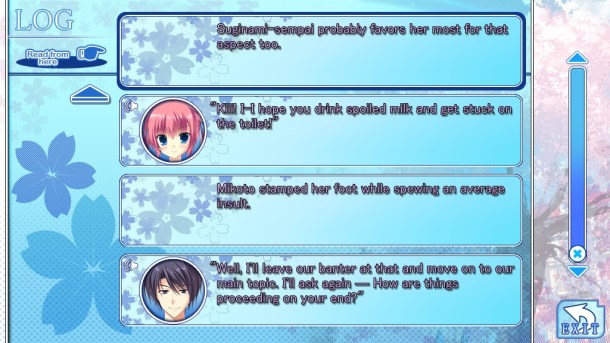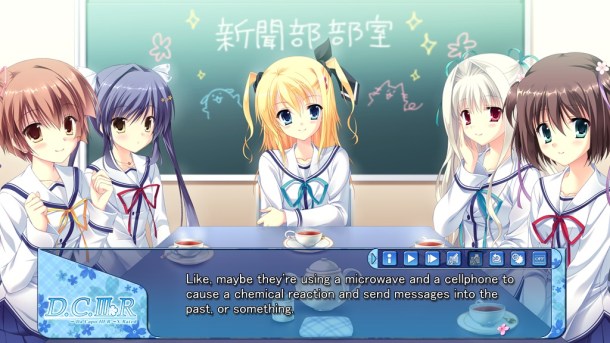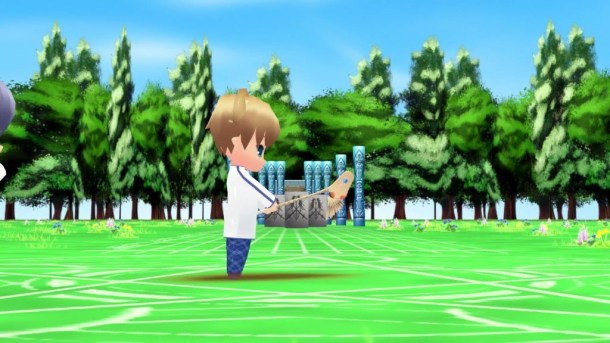
Da Capo III has a lot more in common with Da Capo II than that game did with the first, in terms of art style and character design. However, the story is a serious departure for the series, with its new setting, its greater focus on the magic only slightly present in earlier games, and the one overarching story tying the routes together to a single ending rather than a series of independent routes with one being treated as canon – Nemu’s route in the first game, and Sakura’s in the second. The general structure in the prologue and first chapter of Weather Vane are similar to the other games, with the player choosing places to go during breaks, although setting the alarm has been replaced with selecting actions before going to bed, such as calling friends, listening to the radio or going for a walk around the dorm. It makes it quite easy to figure out what choices lead to what routes, since none of the important decisions are blind while the other nighttime choices just unlock side stories. It also helps that the overarching plot gives a sense of mystery to the story, making it quite satisfying once the game starts to reveal its hand in “Zero” and “Da Capo”. I do wish it established the ancestral relationship between characters more, and explained how the future versions are related to the past versions, but that’s more related to my personal love for lore and the connections between stories than an actual fault of the game. However, while previous games’ protagonists Junichi and Yoshiyuki were mostly normal aside from their abilities to see other people’s dreams and create Japanese sweets from nothing, Kiyotaka Katsuragi is a talented mage. He specializes in dream seer magic, a more sophisticated and refined form of Junichi and Yoshiyuki’s dream ability, and he also uses the sweets creation spell. It was interesting to see where those specific abilities originated within the game’s world.

Similar to Da Capo II, Da Capo III uses some music from earlier games while also having a large selection of new tracks. The OST has been expanded to 82 tracks – up from 27 in the first game and 46 in the second – and runs the gamut from upbeat, relaxing songs such as the slightly Celtic-sounding “Blue Skies”; to refined ones representative of its high-class British setting such as the theme of Weather Vane itself “Petals Fluttering in Late Afternoon”; to intense tracks to accompany the high-tension missions such as “Impulse”; to somber songs to go with each girl’s troubled past, such as Ricca’s slow theme “Cattleya, Blooming Alone”. Each part and each chapter of Weather Vane also has its own opening, although each route shares the same ending theme aside from the unique ones in the side stories. As is always the case with games with Japanese voice acting, I can’t exactly comment on the quality, although I will note that Charles’ voice is somewhat an acquired taste for me.
The art style in Da Capo III is generally similar to that of Da Capo II, although with differences that are particularly notable in the final side story, which has CGs that feature Da Capo II characters with the new art style. The new designs are somewhat more detailed, especially in the eyes and lips. There are also a small number of chibi-style CGs similar to those found in the Grisaia series, as well as one fully animated 3D sequence which looks like they came from the early 2000s. On a technical level, Da Capo III is overall superior to its predecessors, with better editing resulting in fewer typos and errors, plus the new game finally adds the ability to go back to the previous choice, by designing the backlog with the option to go back to any prior dialogue. Also, the sweeping overhead images of Weather Vane and its surroundings are absolutely stunning. I don’t have a whole lot to say about the sex scenes, but the CGs are well-drawn and look good.

Each route swings harder towards being a nakige than previous games in the series although there are still lots of comedic moments, especially in the prologue and chapter one. The Weather Vane characters all have fleshed out back stories, more so than the heroines of the previous games, making the individual routes more interesting and engaging in addition to the mystery of the central story line. Each route is a bit on the short side and there’s only four regular routes, but the game makes up for it with the two final chapters and some fairly lengthy side stories. Even Kiyotaka has his mysteries, which get revealed as you progress through the game. Kiyotaka is somewhat refreshing as a protagonist after Yoshiyuki in the previous game; he’s much smarter overall as a high-level magic prodigy, and is somewhat more in tune with his own feelings than Yoshiyuki and doesn’t take as long to figure out his feelings for the heroines.
There’s no doubt in my mind that Da Capo III is the best game in the series. Its story is significantly more interesting than those of the earlier games, with more fleshed out character backgrounds and routes and an engaging overarching plotline. I wish there was a bit more focus on the Hatsune Island versions of the characters since, as it stands, the choices throughout the prologue seem to have no influence on the proceedings in the Weather Vane parts. However, the game makes up for it with an updated and modern system, gorgeous 1024 x 576 artwork, and an intriguing premise. Between all four routes, the two final stories and the five side stories it comes out around the same length as the other games, around 30 hours. If you like the slice of life genre you will likely find it to be worth the price of either $39.95 USD for the all-ages version on Steam, or $44.95 for the full X-rated version from MangaGamer. I recommend it if you are interested in the genre, especially if you played and enjoyed the previous games.

| Review Score | |
|---|---|
| Overall | |
Review copy provided by publisher




